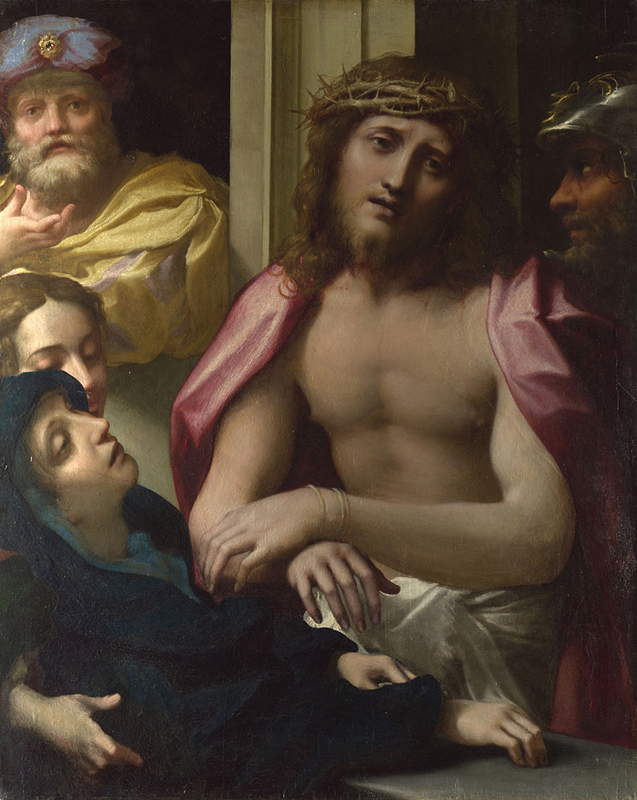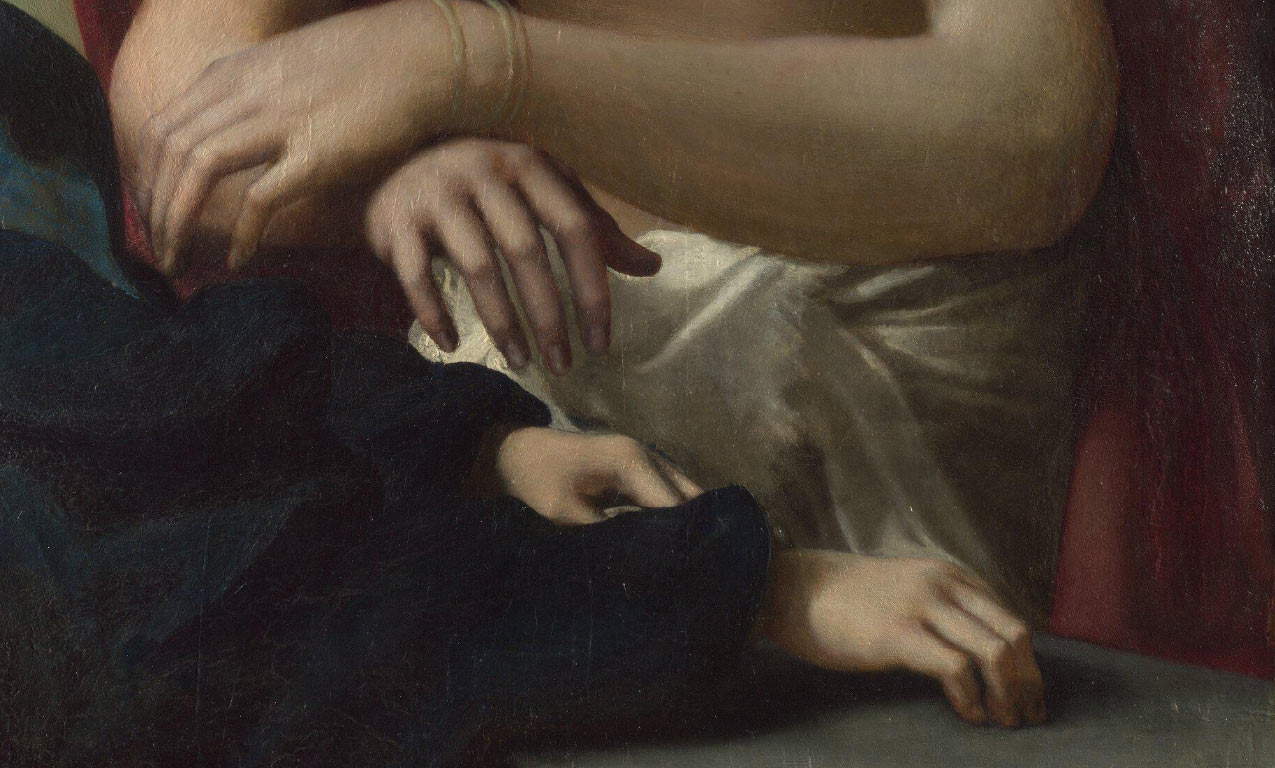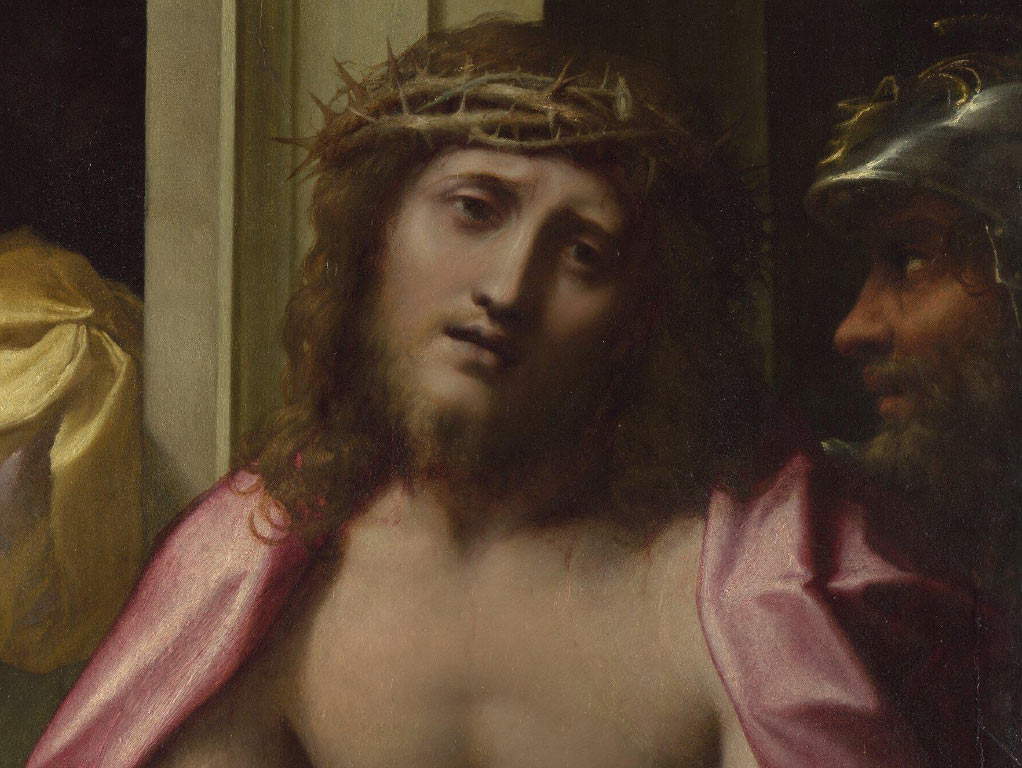Probably between 1526 and 1527 in the context of the magnificent production of his celebrated altarpieces Antonio da Correggio, who was living permanently in Parma where he was directing the difficult wall renovations of the dome of the cathedral, painted a panel of about one meter by eighty dedicated to the sorrowful theme of the “Ecce Homo,” that is, the tremendous moment of Our Lord’s passion just before his crucifixion. This is a rare painting of sorrow in the context of his always vital production filled with the gladness that also provided his signature(laetus) in some of the few contracts we know of. Of the religious subjects that involved compassion and contrite meditation Andrea Muzzi wrote in his time a fine essay that we quote in the bibliography. On this occasion we simply wish to make an observation that we also propose to our readers.

As exegetes have pointed out, Allegri in this panel does not respect the strict Gospel sequence of John where Pilate, after the scourging, repeated that he found no guilt in him and presented him to the High Priests, crowned with thorns, exclaiming, “Behold the Man” (Jn. 19:5). In fact, Correggio gathers in this extremely dramatic moment the very presence of Mary, certainly impossible, and frames a sum of inner feelings that make this work a supremely mystical painting. There appears the whole saving will of Jesus with the surrender of himself to every insult, every torment and finally to the final Sacrifice of death on the cross. Anthony’s pious soul - whom Vasari himself qualifies as a “most good Christian” - rejects the obvious verism of a bleeding body, mangled by the tremendous Roman flogging, and presents Jesus as the divine innocent, just as Pilate himself had declared him to be, but chooses his intact body, accompanied by his gaze as an offering victim, and yet crowned with the terrible thorns, and with those sweetest hands that had just before fulfilled the Eucharistic donation. The theological call that Correggio accomplishes by placing the Mother beside the same hillock where the Son appears is certainly the expression of Mary as the Coredemptrix: the biblical, sacramental reality that the Church has always proclaimed. And Mary’s fainting hands, abandoned in her sister’s arms, slide anxiously over the parapet of the Praetorium, accepting her Son’s sacrifice. David Ekserdjian’s note on this detail is very beautiful.



Correggio’s entire painting is therefore not simply a devotional picture, but rises to the powerful role of a theological document, enshrined in iconography. In this, the figure presenting the scourged Christ to the agitated crowd in the courtyard remains to be decrypted: who is he? and what does “behold the man” mean? The simplistic answer fits the Gospel text: it is Pilate! But that figure does not correspond to a high Roman military officer, as Pontius Pilate certainly was. He is a dowdy, well-dressed man with a well-groomed and solemn beard, wearing a rich turban embellished with a gem. Yes, it is true that other painters have clothed the Caesarean governor in their national costumes, as the young scholar Gian Paolo Lusetti observes in an oral presentation, but Correggio could not have reported such a choice in the context of an event that the painter wants to maintain in all its soteriological, divine significance. The writer’s opinion is that Allegri switched roles and entrusted the demonstrative cry that here becomes almost triumphal to a Pharisee.
The painting is mystical and is deployed on three planes: the one closest to us involves the supreme love that envelops Jesus-victim, and that is the Mother’s love. The third plane, the most distant, is that of condemnation, of the surrender to the Cross, and it is the place of evil, of the Roman palace that yields to the tumult of the mob: on this line stands the bumptious satisfaction of an accuser: “this is how we have reduced him.” In the middle stands the sacred Victim, Jesus. Next to Him is a face, which we will discuss in a moment.
The writer understands the singularity of his own proposal, but wishes to set forth some considerations that would exclude Pilate from the role of the truncated presenter. Meanwhile, let us remember that Correggio was very familiar with Roman military dress: he had been able to record it directly in his travel(s) to Rome. And then we must emphasize Pilate’s own repeated, intense opposition to the condemnation of Jesus, his explicit recognition of innocence; even the “extrema ratio” of scourging had allowed it to save Jesus from death (scourging never preceded crucifixion in Roman judicial custom). Correggio knew this. And here it would be worth noting that the Coptic Christian church from the earliest centuries has held and venerated Pilate and his consort Claudia Valeria as saints. In the undoubted anagogical value of the painting, it is possible that Allegri veridically switched roles.


In the central plane of Allegri’s panel, next to Jesus, already “patiens” because of the extreme pain of his divine awareness, stands the outstretched and darker face of a soldier; this profile with its intensely questioning and almost moved gaze is that of the Centurion who later, at the moment of Jesus’ death on the cross, will cry out, “Truly this man was the Son of God” (Mk. 15:39).
Bibliographical notes</strong Warning: the translation into English of the original Italian article was created using automatic tools.
We undertake to review all articles, but we do not guarantee the total absence of inaccuracies in the translation due to the program. You can
find the original by clicking on the ITA button. If you find any mistake,please contact us.